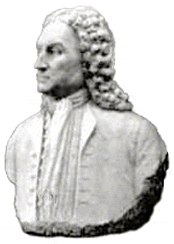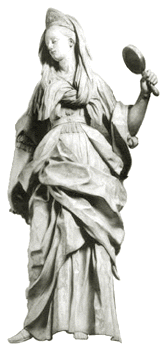...Best of Sicily presents... Best of Sicily Magazine. ... Dedicated to Sicilian art, culture, history, people, places and all things Sicilian. |
by Antonella Gallo | ||
Magazine Index Best of Sicily Arts & Culture Fashion Food & Wine History & Society About Us Travel Faqs Contact Map of Sicily |
He was born in Palermo's Kalsa district in 1656 to Gaspare, a sculptor. At least two of Gaspare's sons followed in his footsteps to become well-known sculptors. Initially, Giacomo collaborated with his brother, Giuseppe. In Palermo, the oratories of Santa Cita Giacomo Serpotta is credited with creating an original technique for polishing stucco, imparting to his work a lustre not unlike that of stone. This is why stucco sculptures are often mistaken for polished stone. But while certain kinds of stone weather the elements admirably, stucco sculpture was usually reserved for architectural interiors --especially churches, civic offices and palatial homes. With Serpotta and other artists of his period, the Baroque styles reached a level of technical creativity previously unknown. The Renaissance and Classical influences in his work are difficult to ignore. Bernini and Gagini have been cited as inspirations. Serpotta is the artist said to have elevated stuccowork in Italy from a craft to a high art. His work influenced southern Italian sculptors, naturally, but his fame soon spread beyond Italian shores. In Serpotta's hands, monumental figures seemed to come alive. However competent his sculpture was technically, it is this seemingly intangible quality that defined his work and influenced, on an aesthetic level, a generation of Rococo sculptors, particularly in Germany. Serpotta used the placement of elements in asymmetrical or unorthodox fashion to create perspective and realism. One might find the Serpotta sculpture of a child "seated" at the base of a larger statue rather than sitting in a rigid fashion next to it. The figures in Palermo's Church of San Francesco d'Assisi almost seem to be floating in space. They certainly seem to have been frozen in time. About the Author: Artist Antonella Gallo teaches art in Rome. | |
Top of Page |
 To understand the artform we must first understand its medium. Stucco, whose composition has evolved through the centuries, is made from fine plaster and other compounds. It became popular for molding architectural decoration in the seventeenth century. Essentially, there are two ways to create realistic solid forms --sculpting them from a rock or building them up with clay and other substances. Traditional stone sculpture presumes defining a form from a solid mass, forcing the artist to think in terms of the absence of the space (negative space) he carves away to reveal form. Stucco and terra cotta, conversely, entail the development of forms from existing mass. In other words, mass is created directly with a workable substance (stucco or clay), rather than removed from a brittle substance (stone). In reality, the two artforms --stone sculpture and "plastic" modeling-- require completely different ways of thinking on the part of the artist. Moreover, stone sculpture is not a very forgiving technique. One error is sufficient to ruin an evolving statue. Clay and terra cotta, however, offer slightly more flexibility. Stucco sculpture actually allows the artist to build up forms but also to carve into them. Unlike stone sculpture, however, stucco forces the artist to work rather rapidly, before the substance dries. In its most evolved form, stucco offers the benefits of both clay and stone. Giacomo Serpotta, one of Italy's lesser known masters, was expert in the stucco technique.
To understand the artform we must first understand its medium. Stucco, whose composition has evolved through the centuries, is made from fine plaster and other compounds. It became popular for molding architectural decoration in the seventeenth century. Essentially, there are two ways to create realistic solid forms --sculpting them from a rock or building them up with clay and other substances. Traditional stone sculpture presumes defining a form from a solid mass, forcing the artist to think in terms of the absence of the space (negative space) he carves away to reveal form. Stucco and terra cotta, conversely, entail the development of forms from existing mass. In other words, mass is created directly with a workable substance (stucco or clay), rather than removed from a brittle substance (stone). In reality, the two artforms --stone sculpture and "plastic" modeling-- require completely different ways of thinking on the part of the artist. Moreover, stone sculpture is not a very forgiving technique. One error is sufficient to ruin an evolving statue. Clay and terra cotta, however, offer slightly more flexibility. Stucco sculpture actually allows the artist to build up forms but also to carve into them. Unlike stone sculpture, however, stucco forces the artist to work rather rapidly, before the substance dries. In its most evolved form, stucco offers the benefits of both clay and stone. Giacomo Serpotta, one of Italy's lesser known masters, was expert in the stucco technique. and San Lorenzo bear Serpotta's mark. So does the medieval church of Sant'Agostino. In the Church of San Francesco d'Assisi, Serpotta created several statues, including Modesty (shown here) and the other Virtues, around 1723. The artist died in 1732. His son, Procopio, was a competent stucco sculptor but never achieved Giacomo's mastery of this unique art.
and San Lorenzo bear Serpotta's mark. So does the medieval church of Sant'Agostino. In the Church of San Francesco d'Assisi, Serpotta created several statues, including Modesty (shown here) and the other Virtues, around 1723. The artist died in 1732. His son, Procopio, was a competent stucco sculptor but never achieved Giacomo's mastery of this unique art.